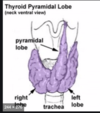Blue Boxes Triangles Lecture Flashcards
(57 cards)
What are some of the common causes of cervical pain?
Inflamed lymph nodes muscle strain protruding IC discs
What is the major underlying cause of chronic cervical pain?
Bony abnormalities or trauma
If somebody was strangled at the throat, what would you expect to see? With this injury, what illness would you be cautious of and why?
A fracture of the hyoid bone Would be cautious of an aspiration pneumonia When there is a fracture in the hyoid bone, there is a depression of the body of the hyoid bone on the thyroid cartilage which causes an issue with elevation of the hyoid, which impedes the movements of the tongue When this happens, there is not as much separation between the airway and the GI tract which can lead to an aspiration pneumonia because shit gets into the lungs
If the cervical branch of the facial nerve was injured, what would result?
Paralysis of the platysma: the skin would fall away from the neck in slack folds
What would happen if there is an infection in between the investing layer of deep fascia and the muscular part of the pretracheal fascia that is surrounding the infra hyoid muscles?
The infection will typically not spread past the superior edge of the manubrium
What would happen if there is an infection in between the investing layer of the fascia and the visceral later of the pretracheal fascia?
The infection can spread into the thoracic cavity and to the pericardium
What could happen if there is an abscess that is posterior to the SCM?
Can perforate into the prevertebral layer of the deep cervical fascia and enter into the retropharyngeal space, which can lead to difficulty swallowing and speaking
Where can infections in the head travel?
Can travel posterior to the esophagus and enter the posterior mediastinum OR can travel anterior to the trachea and enter the anterior mediastinum
What is the common cause of a congenital torticollis?
A fibrous tissue tumor that develops in the SCM before or shortly after birth which causes the typical presentation of torticollis
Describe a right cardiac catheterization
Used to take pressure measurements in the right side of the heart A catheter is introduced into the internal jugular vein and taken through the right brachiocephalic trunk and into the superior vena cava to the right side of the heart
Describe in detail what happens if the EJV is severed along the posterior border of the SCM
Lumen is held open by the investing layer of deep cervical fascia and the negative intrathoracic pressure air will suck air into the vein, resulting in a churning noise and cyanosis This can cause the right side of the heart to be filled with “froth” (air and blood) and eventually it will stop working
If a patient presented with decreased muscle strength of turning the head to the right side against resistance and abnormal neck movements including weakened elevation of the shoulders is noted, what could be one of the clinical possibilities?
lesion in the spinal accessory nerve
Drooping of the shoulder is an indication of what?
Lesion in the spinal accessory nerve
What would result in the severance of a phrenic nerve?
paralysis of half of the diaphragm
Describe a phrenic nerve crush
The surgeon compresses the nerve with forceps in order to damage the nerve and paralyze half of the diaphragm which is common in a diaphragmatic hernia repair
How do nerve blocks in the cervical plexus work?
Anesthetic is injected along the posterior border of the ECM, specifically at the nerve point of the neck (Erbs); half of the diaphragm will be effected because of the phrenic nerve coming off C3, C4, and C5
How would an injury to the supra scapular nerve happen? What would be the result?
Fracture to the middle third of the clavicle can damage the supra scapular nerve Loss of lateral rotation of the humerus in the glenohumeral joint waiters tip position
Which artery makes up for the ligation (decrease in blood flow-backwards almost) in the external carotid artery?
Descending branch of the occipital artery provides the collateral circulation and anastomoses with the vertebral and deep cervical arteries
If the vagus or the recurrent laryngeal nerves are damaged in surgery, what sx could present?
Alteration in the voice because these nerves supply the laryngeal muscles
What are the risks of a carotid occlusion?
TIA Stroke
What is a carotid endarterectomy?
Opening the affected artery and removing the plaque that lines the walls
What happens in the event of carotid sinus hypersensitivity?
External pressure on the carotid artery can cause a decrease in heart rate, fall in blood pressure, and syncope *** if someone has this, you do not want to check a carotid pulse, because it is sensitive and could cause them to faint
What is the function of the carotid bodies?
To monitor the amount of oxygen that is present in the blood before it gets to the brain can also monitor the amount of CO2 that is present in the blood
What nerve carries the information from the carotid bodies to the respiratory centers?
Glossopharyngeal nerve (IX)



